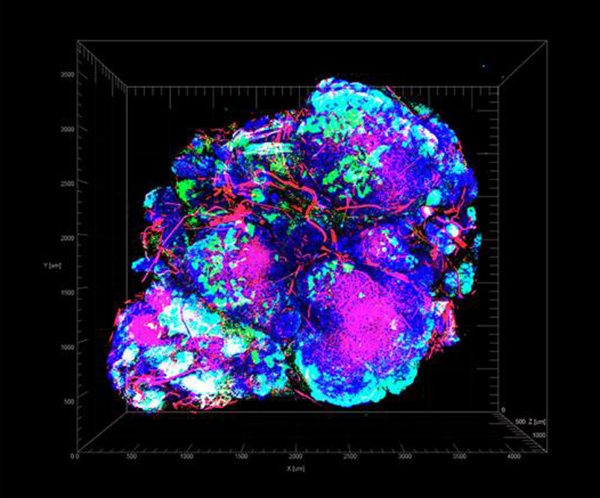Deep inside tumors, where oxygen is scarce, cancer cells are reduced to scrounging metabolites from their surroundings. A particularly valuable metabolite happens to be aspartate. If oxygen-starved cancer cells can pick up aspartate, report scientists based at Rockefeller University, they survive, grow, and proliferate despite their suffocating conditions.
The hunger for aspartate, the Rockefeller University scientists suggest, could be exploited in future cancer treatments. For example, treatments could stimulate cancer cells’ appetite for aspartate while interfering with aspartate synthesis and aspartate uptake. Treatments that could prevent aspartate uptake look especially promising now that the Rockefeller team, led by Kivanç Birsoy, Ph.D., head of the Laboratory of Metabolic Regulation and Genetics, has found that the best aspartate scroungers depend on a gene called SLC1A3.
Detailed findings appeared June 25 in the journal Nature Cell Biology, in an article entitled “Aspartate Is a Limiting Metabolite for Cancer Cell Proliferation under Hypoxia and in Tumors.” This article describes how the Rockefeller team assessed proliferation of cancer cells upon inhibition of the mitochondrial electron transport chain (ETC), a major metabolic pathway requiring molecular oxygen. This work, the scientists indicated, was designed to shed light on the limiting metabolites for proliferation under hypoxia and in tumors.
To zero in on the most important reactions, Javier Garcia-Bermudez, Ph.D., a postdoctoral associate in Birsoy's group, mimicked oxygen deprivation in cancer cells harvested from 28 patients—including cancers from blood, stomach, breast, colon, and lung—that he cultured in the lab. Many of these cells exhibited stunted growth under low-oxygen-like conditions, but others were less sensitive, and some weren't bothered at all by the treatment.
In comparing these cells' production of chemicals, or metabolites, Garcia-Bermudez noticed that the most sensitive ones lost the amino acid aspartate under oxygen deprivation. Cells can't make aspartate without oxygen, but it seemed as if the resistant cells were able to obtain it from their environment.
In the sensitive cells, a lack of aspartate would affect not only the production of new proteins, but also several other processes that rely on aspartate, such as the synthesis of genetic material.
Birsoy says he was surprised to see that so much of the oxygen-deprivation problem came down to this one amino acid. He had expected many more metabolites would depend on oxygen supply.
“Cell lines least sensitive to ETC inhibition maintain aspartate levels by importing it through an aspartate/glutamate transporter, SLC1A3,” the authors wrote. “Genetic or pharmacologic modulation of SLC1A3 activity markedly altered the sensitivity of cancer cells to ETC inhibitors.”
When Garcia-Bermudez turned on SLC1A3 in the lab-grown cancers that were normally sensitive to low oxygen, they grew faster. The same was true when he transplanted the tumors into mice, providing further support for the idea that aspartate can be a limiting factor for tumor growth when oxygen is scarce. “This is something they're really starving for,” said Birsoy.
The discovery might offer opportunities for creating drugs to stab cancers in this particular Achilles' heel, making them even hungrier for aspartate. There might be several ways to prevent cancer cells from getting aspartate, Birsoy suspects, by blocking their methods to make the amino acid or take it up from their surroundings.
“Acquisition of the ability to import aspartate through upregulation of gene expression or genomic amplification of aspartate transporters may be an important metabolic adaptation for tumors that develop in or are selected by transient rounds of hypoxia,” the Rockefeller team concluded. “Our findings indicate that low oxygen levels may constrain in vivo tumor growth through aspartate limitation and pathways relevant to aspartate availability could thus be targeted for therapy in a subset of tumors.”
If Birsoy and colleagues are right, an antiaspartate treatment might one day provide a supplement to typical chemotherapy and radiation, and it could potentially be effective for any type of tumor containing oxygen-starved areas, parts of tumors that tend to resist typical chemotherapy and radiation.
Birsoy envisions a sort of one-two punch—one treatment for the parts of a tumor that are well-supplied with oxygen, and an aspartate blocker for the rest.
That sort of drug combo is a long way off, however. For starters, Birsoy now plans to investigate possible drugs that would interfere with aspartate production in the lab.






